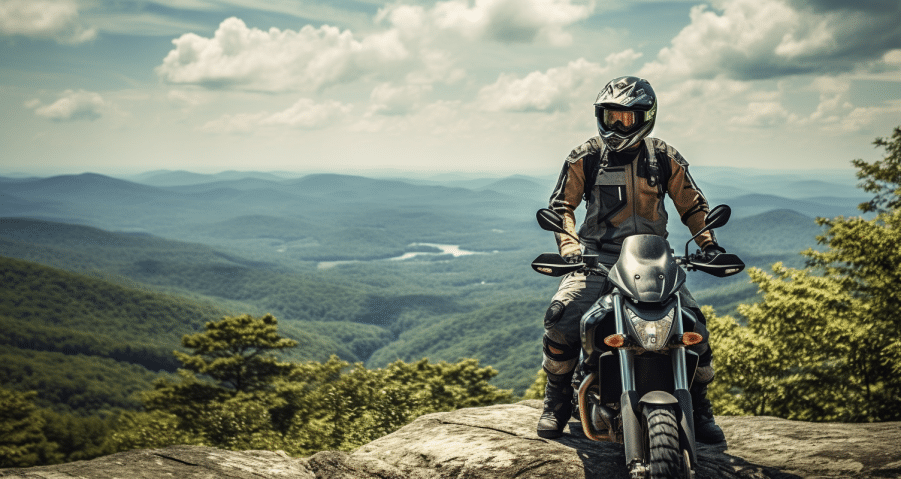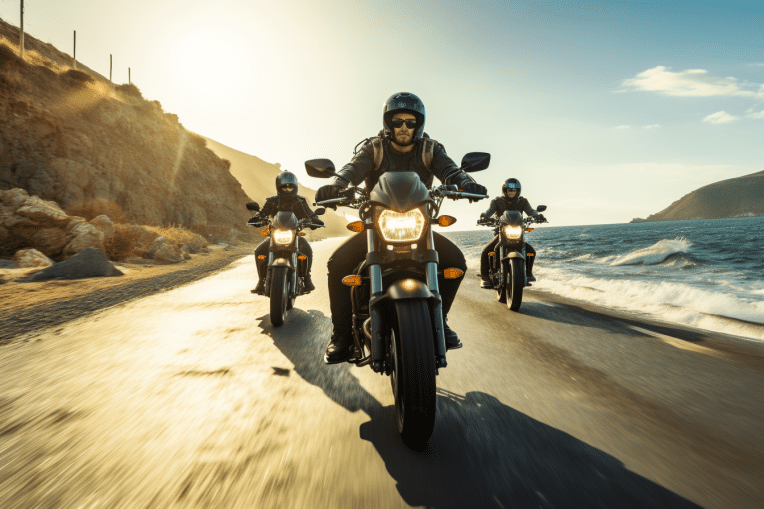When it comes to motorcycle road trips, the spell of the open road, the thrill of adventure, and the freedom to explore new horizons can be irresistible. But for those who seek the ultimate thrill, a risky motorcycle road trip is the answer.
A motorcycle road trip checklist is a comprehensive list of items, tasks, and considerations that motorcyclists should review and complete before embarking on a road trip. It is designed to ensure safety, preparedness, and an enjoyable journey. This checklist typically covers a wide range of aspects.
Riders are taken through challenging terrains, unpredictable weather, and remote locations, making them more exciting yet considerably riskier. To ensure you ride safely and fearlessly, we present this ultimate risky motorcycle road trip checklist.
I. Pre-Trip Planning
A. Destination Research
- Route Selection: Choose roads that match your skill level and the capabilities of your motorcycle. Steep mountain passes, gravel roads, and desolate stretches can offer exciting challenges, but they demand careful consideration.
- Weather and Terrain Considerations: Be aware of the climate and terrain you’ll encounter. Riding in the mountains or deserts may expose you to extreme temperature variations.
- Local Laws and Regulations: Different regions may have specific rules for motorcyclists, including helmet laws and speed limits. Research and comply with these regulations to avoid legal complications.
B. Motorcycle Inspection
- Check for Mechanical Issues: Ensure your motorcycle is in excellent working condition. Inspect the engine, transmission, and electrical components.
- Fluid Levels: Regularly check oil, coolant, and brake fluid levels to prevent overheating and maintain braking performance.
- Tire Condition and Pressure: Invest in high-quality, durable tires, and maintain proper tire pressure for optimal traction and stability.
- Lights and Signals: Ensure all lights, including headlights, turn signals, and brake lights, are functioning correctly.
- Brakes: Test your brakes for responsiveness and check the brake pads for wear.
- Suspension and Steering: A well-maintained suspension system and responsive steering are essential for control on risky roads.
C. Gear and Equipment
- Helmet: Always wear a DOT-approved helmet to protect your head and face in case of accidents.
- Protective Clothing: Invest in a high-quality riding jacket, pants, and gloves made of durable materials like leather or textiles.
- Riding Boots: Sturdy, ankle-supporting boots can provide stability and protection.
- Eyewear: Whether it’s goggles, a visor, or sunglasses, protect your eyes from debris and UV rays.
- Rain Gear: Pack waterproof gear, including a rain suit, to stay dry in unpredictable weather.
- First Aid Kit: Carry basic medical supplies to handle minor injuries or provide first aid to others.
- Emergency Tools: A tire repair kit, multi-tool, and spare parts are essential for on-the-go fixes.
- GPS or Maps: Reliable navigation tools help you stay on course even in remote areas.
D. Emergency Contacts
- Share Your Itinerary: Before embarking on your journey, share your trip details with a trusted person who can assist in case of emergencies.
- Know Local Emergency Numbers: Familiarize yourself with local emergency services and numbers specific to the regions you’ll be traveling through.
E. Travel Insurance
- Health Insurance: Ensure your health insurance covers potential injuries, and consider additional coverage for risky activities.
- Motorcycle Insurance: Verify your motorcycle insurance is up-to-date, covering any modifications or additional equipment.
- Roadside Assistance: Enroll in a roadside assistance program that caters to motorcyclists.
II. On-The-Road Safety
A. Riding Techniques
- Defensive Riding: Adopt a defensive riding style, anticipating the actions of other road users and avoiding dangerous situations.
- Proper Body Position: Maintain the correct body position on the bike for balance and control, especially when navigating challenging terrain.
- Braking and Accelerating: Apply brakes and throttle smoothly to avoid skidding or losing control.
- Riding in Groups: If riding with others, establish clear communication and riding formations to enhance safety.
B. Maintenance Checks
- Daily Inspection: Before setting off daily, inspect your motorcycle for tire condition, brake functionality, lights, and fluid levels.
C. Navigation
- Regularly Check Your Route: Periodically review your planned route to avoid unexpected road closures or changes.
- Plan Rest Stops and Refueling Locations: Ensure you have access to fuel, food, and accommodations along your route, especially in remote areas.
D. Weather Monitoring
- Keep an Eye on Weather Forecasts: Staying updated on weather conditions allows you to make informed decisions about riding or seeking shelter.
- Adjust Plans for Severe Weather: Don’t hesitate to modify your route or postpone your ride if severe weather is expected.
E. Rest and Hydration
- Take Regular Breaks: Frequent stops help combat fatigue and allow you to stretch your legs.
- Stay Hydrated and Eat Well: Proper hydration and nutrition are essential to maintain your energy and focus.
F. Riding Buddy (if Possible)
- Traveling with a companion provides an extra layer of safety. You can assist each other in case of breakdowns or accidents.
G. Defensive Riding Mindset
- Always Assume Other Drivers Don’t See You: Stay alert and anticipate that car and truck drivers might not notice you on the road.
- Maintain a Safe Following Distance: Keep a safe gap between you and the vehicle in front to give you more time to react to sudden hazards.
- Be Prepared to React: Stay mentally prepared for quick decision-making, and be ready to swerve or brake if a hazardous situation arises.
III. Emergency Preparedness
A. Emergency Kit
- Basic First Aid Supplies: Include bandages, antiseptic wipes, pain relievers, and any personal medications.
- Tool Kit and Spare Parts: Essential tools such as wrenches, pliers, and spare fuses, along with spare parts like bulbs and fuses.
- Emergency Contact List: Create a list with contact information for loved ones, emergency services, and roadside assistance.
- Identification and Important Documents: Carry identification, motorcycle registration, insurance information, and a photocopy of your passport.
B. Communication
- Mobile Phone with a Charger: Keep your phone charged and invest in a durable, waterproof case.
- Two-Way Radios: If traveling in a group, use two-way radios for real-time communication.
- Satellite Communicator: In remote areas, a satellite communicator can provide a lifeline in case of an emergency.
C. Maps and GPS
- Carry Paper Maps as a Backup: Technology can fail, so always have physical maps.
- Know How to Use Your GPS Device: Familiarize yourself with your GPS or navigation app to avoid getting lost.
D. Breakdown or Accident Protocol
- Know How to Handle a Breakdown or Accident: Stay calm, assess the situation, and take appropriate actions.
- Safety Vest and Flares: Improve visibility in emergencies with high-visibility clothing and flares.
IV. Environmental Considerations
A. Riding in Extreme Heat
- Hydration Plan: Drink water regularly to prevent dehydration.
- Cooling Gear: Invest in cooling vests or products that can help maintain a comfortable body temperature.
B. Riding in Cold or Wet Conditions
- Layered Clothing: Dress in layers to retain warmth and stay dry.
- Heated Gear: Electrically heated clothing can be a game-changer in cold and wet conditions.
- Anti-Fog Solutions for Visors: Apply anti-fog products to your visor to maintain clear visibility.
C. Riding at Night
- High-Visibility Clothing and Gear: Wear reflective or brightly colored clothing to enhance your visibility.
- Bright Headlights: Use your high beams where appropriate to improve your own visibility.
V. Checkpoints and Updates
A. Regularly Review Your Progress Against Your Itinerary
- Ensure you’re on track and meeting your planned milestones.
- Make any necessary adjustments to your schedule based on real-time conditions.
B. Update Your Emergency Contacts with Any Changes
- If you change your route, accommodations, or contact information, inform your emergency contacts.
C. Share Your Current Location and Status with a Trusted Person
- Send regular updates about your location and well-being to your designated contact.
VI. Post-Trip Evaluation
A. Reflect on the Trip and Areas for Improvement
- Analyze what went well and what could have been done differently for a smoother and safer journey.
- Share your experiences and lessons learned with fellow riders, contributing to a collective knowledge pool.
VII. Motorcycle Shipping Made Easy
If you’re considering the need to transport your bike across North America, don’t hesitate to reach out to us at AA Motorcycle Shipping. We specialize in providing immediate and unmatched price quotes for individuals seeking to move their bikes between different regions of the continent. Our services encompass reliable, door-to-door transportation, and our extensive experience spanning decades has allowed us to master this craft.
With state-of-the-art loading equipment and well-equipped trucks, we guarantee the safe and damage-free delivery of your motorcycle to your desired destination. Your bike will be in capable hands as we ensure it reaches its intended location without a scratch.
Conclusion
Risky motorcycle road trips are the stuff of legends, providing riders with unforgettable adventures and challenges. However, tackling these journeys requires meticulous preparation, sound judgment, and a dedication to safety.
Our Ultimate Motorcycle Road Trip Checklist serves as your guide to planning and executing such journeys with confidence. Remember that while adventure and risk go hand in hand, a well-prepared and safety-conscious rider is the one who returns home with incredible stories and cherished memories. Ride safely, ride fearlessly, and conquer the road.




